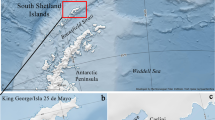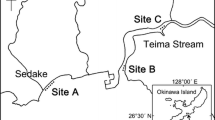Abstract
This study presents data on fish assemblage structure for the relatively pristine and understudied Antarctic coastal zone (5–25 m). A total of 545 Notothenioidei and Bathydraconidae fish (eight species) were caught in the Prince Gustav Channel (James Ross Island, eastern Antarctic Peninsula) using Nordic multi-mesh benthic gill nets between January and February 2014. Trematomus hansoni dominated at 5 m and Trematomus bernacchii at 15 m, with Gobionotothen gibberifrons and Trematomus newnesi subdominant. Dominance at 25 m resembled that at 15 m. Despite relatively low numbers, species richness, abundance and biomass appeared to increase with depth. While T. bernacchii, T. hansoni, G. gibberifrons and Notothenia coriiceps all displayed multiple size (and probably age) groups, most T. newnesi ranged between 10 and 15 cm. Subsamples of G. gibberifrons and T. bernacchii showed a 1:1 adult/immature ratio, with minimum adult and maximum immature length/weight overlapping. Females outnumbered males, with a ratio of 2.8:1 for G. gibberifrons and 4.8:1 for T. bernacchii. The diet comprised mostly benthic taxa (isopods, gammarids, gastropods, polychaete worms). While G. gibberifrons appeared opportunistic, T. bernacchii specialised more on isopods. Our results highlight the possible importance of the Antarctic inshore zone as feeding habitat, despite frequent ice cover/scouring. We suggest that recent prolonged summer ice cover over the eastern side of the Antarctic Peninsula could have important impacts on inshore fish communities and food webs, though further in-depth studies are needed to confirm our results.



Similar content being viewed by others
Notes
Also previously known as N. coriiceps neglecta Nybelin 1951 (Miller 1993). Note, however, that neither FishBase (Froese and Pauly 2012) nor Gon and Heemstra (1990) recognises neglecta as a separate species or subspecies as identification was based on just two type samples and the species shows great variation. Hence, the most common name in use today is the bullhead notothen (or black rockcod) N. (Notothenia) coriiceps Richardson, 1844.
References
Barrera-Oro ER (2002) The role of fish in the Antarctic marine food web: differences between inshore and offshore waters in the southern Scotia Arc and western Antarctic Peninsula. Antarct Sci 14:293–309
Beers JM, Sidell BD (2011) Thermal tolerance of Antarctic Notothenioid fishes correlates with level of circulating haemoglobin. Physiol Biochem Zool 84:353–362
Burchett MS, Sayers PJ, North AW, White MG (1983) Some biological aspects of the nearshore fish populations at South Georgia. Br Antarct Surv B 59:63–74
Casaux R, Mazzotta AS, Barrera-Oro E (1990) Seasonal aspects of the biology and diet of nearshore nototheniid fish at Potter Cove, South Shetland Islands, Antarctica. Polar Biol 11:63–72
Casaux R, Barrera-Oro E, Baroni A, Ramón A (2003) Ecology of inshore Notothenioid fish from the Danco Coast, Antarctic Peninsula. Polar Biol 26:157–165
Cheng C-HC, Detrich HW (2007) Molecular ecophysiology of Antarctic nototheniid fishes. Philos Trans R Soc Lond B 362:2215–2232
Cheung WWL, Pitcher TJ, Pauly D (2005) A fuzzy logic expert system to estimate intrinsic extinction vulnerabilities of marine fishes to fishing. Biol Conserv 124:97–111
Clarke A, Gore DJ (1992) Egg size and composition in Ceratoserolis (Craustacea: Isopoda) from the Weddell Sea. Polar Biol 12:129–134
Clarke A, Johnston IA (1996) Evolution and adaptive radiation of Antarctic fishes. Trends Ecol Evol 11:212–218
Daniels RA (1982) Feeding ecology of some fishes of the Antarctic Peninsula. Fish Bull 80:575–588
Davis C, Li J, McConnell RM, Frey MM, Hannah E (2005) Snowfall-driven growth in east Antarctic ice sheet mitigates recent sea-level rise. Science 308:1898–1901
Donnelly J, Torres JJ, Sutton TT, Simoniello C (2004) Fishes of the eastern Ross Sea, Antarctica. Polar Biol 27:637–650
Eastman JT (1991) Evolution and diversification of Antarctic Notothenioid fishes. Am Zool 31:93–109
Eastman JT (2005) The nature of the diversity of Antarctic fishes. Polar Biol 28:94–107
Eastman JT, McCune AR (2000) Fishes on the Antarctic continental shelf: evolution of a marine species flock? J Fish Biol 57:84–102
Ekau W (1990) Demersal fish fauna of the Weddell Sea, Antarctica. Antarct Sci 2:129–137
Fischer W, Hureau JC (eds) (1985) FAO species identification sheets for fishery purposes Southern Ocean: Fishing Areas 48, 58, and 88 (CCAMLR Convention Area), Roma, FAO 2:233–470
Froese R, Pauly D (eds) (2012) FishBase. World Wide Web electronic publication/(www.fishbase.org). Electronic version. Accessed March 2015
Gon O, Heemstra PC (eds) (1990) Fishes of the Southern Ocean. JLB Smith Institute of Ichthyology, Grahamstown
Hureau JC (1970) Biologie comparie de quelques poissons antarctiques (Nototheniidae). Bull Inst Oceanogr MOMCO 68:l-244 (in French)
Hyslop EJ (1980) Stomach content analysis-a review of methods and their application. J Fish Biol 17:411–429
Klánová J, Matykiewiczova N, Macka Z, Prosek P, Laska K, Klan P (2008) Persistent organic pollutants in soil and sediments from James Ross Island, Antarctica. Environ Pollut 15:416–423
Knox GA (2006) Biology of the Southern Ocean, 2nd edn. CRC Press, USA
Kock KH (1989) Reproduction in fish around Elephant Island. Arch FischWiss 39(1):171–210
Kock KH, Stransky C (2000) The composition of the coastal fish fauna around Elephant Island (South Shetland Islands, Antarctica). Polar Biol 23:825–832
Kock KH, Schneppenheim R, Siegel W (1984) Contribution to the fish fauna of Weddell Sea. Archiv für Fischereiwissenschaft 34:103–120
La Mesa M, Dalú M, Vacchi M (2004) Trophic ecology of the emerald notothen Trematomus bernacchii (Pisces, Nototheniidae) from Terra Nova Bay, Ross Sea, Antarctica. Polar Biol 27:721–728
Láska K, Prošek P, Budik L (2010) Seasonal variation of air temperature at the Mendel Station, James Ross Island, in the period of 2006–2009. In: EGU Geophysical Research Abstracts, vol 12, p. 3880
Linkowski TB, Zukowski C (1980) Observation on the growth of Notothenia coriiceps neglecta Nybelin and Notothenia rossii marmorata Fischer in Admiralty Bay (King George Island, South Shetland Islands). Pol Polar Res 1:155–162
Loeb VJ, Kellerman AK, Koubbi P, North AW, White MG (1993) Antarctic larval fish assemblages: a review. B Mar Sci 53:416–449
Marschoff ER, Barrera-Oro ER, Alescio NS, Ainley DG (2012) Slow recovery of previously depleted demersal fish at the South Shetland Islands, 1983–2010. Fish Res 125–126:206–213
Mašová Š, Kašparová E (2012) Preliminary report on fish diversity at the Prince Gustav Channel, the northern part of the James Ross Island, Antarctica. Czech Pol Rep 2:92–102
Matschiner M, Hanel R, Salzburger W (2009) Gene flow by larval dispersal in the Antarctic nototheniid fish Gobionotothen gibberifrons. Mol Ecol 18:2574–2587
Miller RG (1993) A history and atlas of the fishes of the Antarctic Ocean. Foresta Institute, Nevada
Natarajan AV, Jhingran AG (1961) Index of preponderance—a method of grading the food elements in the stomach analysis of fishes. Indian J Fish 8:54–59
Nývlt D, Braucher R, Engel Z, Mlčoch B, Team ASTER (2014) Timing of the Northern Prince Gustav Ice Stream retreat and the deglaciation of the northern James Ross Island, Antarctic Peninsula during the last glacial–interglacial transition. Quaternary Res 82:441–449
Rakusa-Suszczewski S, Cz Zukowski (1980) Blood of Antarctic fishes Notothenia rossi marmorata Fischer and Notothenia neglecta Nybelin. Pol Polar Res 1:103–108
Reece A (1950) The ice of crown prince gustav channel, Graham Land, Antarctica. J Glaciol 1:404–409
Richardson MG (1975) The dietary composition of some Antarctic fish. Brit Antarct Surv B 41(42):113–120
Ross RM, Quetin LB (1986) How productive are Antarctic krill? Bioscience 36:264–269
Ruhl HA, Hastings PA, Zarubick LA, Jensen RM, Zdzitowiecki K (2003) Fish populations of Port Foster, Deception Island, Antarctica and vicinity. Deep-Sea Res PT II 50:1843–1858
Simmonds I (2015) Comparing and contrasting the behaviour of Arctic and Antarctic sea ice over the 35 year period 1979–2013. Ann Glaciol 56:18–28
Skora KE, Neyelov AV (1992) Fish of Admiralty Bay (King George Island, South Shetland Islands, Antarctica). Polar Biol 12:469–476
Ślósarczyk W, Wysokiński A (1980) Ichthyological and fishery studies of the shelf fishing grounds in the region of Kergzelen Islands (Antarctic). Pol Polar Res 1:173–190
Targett TE (1981) Trophic ecology and structure of coastal Antarctic fish communities. Mar Ecol 4:243–263
Vacchi M, La Mesa M (1995) The diet of the Antarctic fish Treamatomus newnesi Boulenger 1902 (Nototheniidae) in Terra Nova bay, Ross Sea. Antarct Sci 7:37–38
Vacchi M, La Mesa M, Greco S (2000) The coastal fish fauna of Terra Nova Bay, Ross Sea, Antarctica. In: Faranda FM, Guglielmo L, Ianora A (eds) Ross Sea Ecology. Springer-Verlag, Berlin, pp 457–468
Žukowski C (1980) Catches of fishes of the genus Notothenia and Trematomus at Admiralty Bay (King George Island, South Shetland Islands) in the winter-spring season 1977. Pol. Polar Res 1:163–167
Acknowledgments
This study was made possible thanks to financial support from the Grant Agency of the Czech Republic (ECIP Project No. P505/12/G112). We would like to express our thanks for permission to use the J.G. Mendel Czech Antarctic Station on James Ross Island in 2014 and to all our expedition colleagues for technical help while stationed there. We would also like to thank A. Bryjová and J. Bryja of the Institute of Vertebrate Biology, Czech Academy of Sciences, for their help in analysing the DNA samples.
Author information
Authors and Affiliations
Corresponding author
Ethics declarations
Conflict of interest
The authors declare that they have no conflict of interest.
Rights and permissions
About this article
Cite this article
Jurajda, P., Roche, K., Sedláček, I. et al. Assemblage characteristics and diet of fish in the shallow coastal waters of James Ross Island, Antarctica. Polar Biol 39, 2299–2309 (2016). https://doi.org/10.1007/s00300-016-1896-z
Received:
Revised:
Accepted:
Published:
Issue Date:
DOI: https://doi.org/10.1007/s00300-016-1896-z




